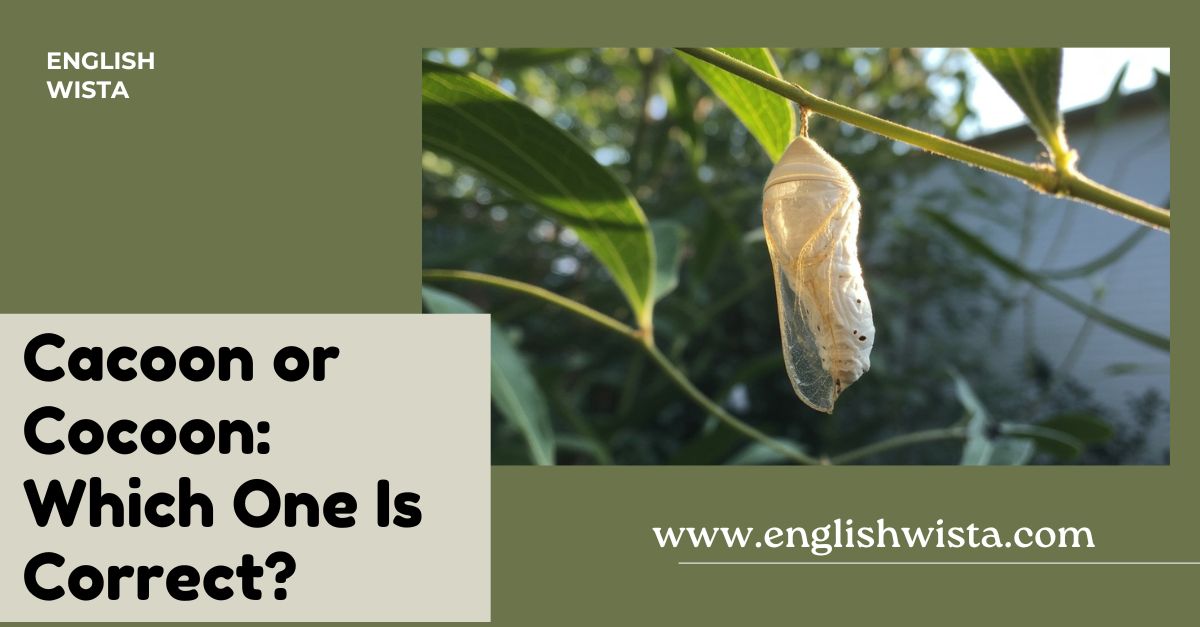Have you ever typed out the word cacoon when talking about butterflies, only to realize it doesn’t quite look right? Don’t worry you’re not alone! Many people get confused between cacoon and cocoon. These two spellings sound almost the same when spoken, but only one of them is actually correct in English.
In this article, we’re going to explore this little spelling puzzle step by step. By the end, you’ll know exactly which word to use, what it means, where it comes from, and how to use it in real life. We’ll also add some fun facts and examples so the idea really sticks. Ready? Let’s dive in!
What’s the Correct Spelling?
The correct spelling is cocoon.
The word cacoon is simply a common misspelling. While it may look close, it’s not a recognized English word. If you try to use cacoon in formal writing or even in a dictionary search, you won’t find it. So, whenever you’re describing the silky covering that protects caterpillars or insects during transformation, the right word to use is cocoon.
What Does Cocoon Mean?
A cocoon is:
- A silky protective covering spun by certain insects, especially caterpillars, as they develop into adults.
- Figuratively, it can also mean a protective layer or a safe, cozy place.
In simple terms: a cocoon is like a sleeping bag for insects, especially butterflies and moths.
Why Do People Write Cacoon Instead?
Spelling mistakes happen for a few reasons:
- Sound similarity: When you say cocoon out loud, it almost sounds like cacoon. This makes people think the word has an a in the middle.
- Typing habits: Our fingers sometimes slip into familiar letter patterns, and “ca” is a very common starting combination in English words.
- Lack of exposure: If you haven’t seen the word written down often, you’re more likely to guess the spelling incorrectly.
So, it’s not unusual to see people write cacoon, but now you know it’s simply a mistake.
How Do You Pronounce Cocoon?
The pronunciation is: kuh-KOON.
- The first syllable sounds like “kuh.”
- The second syllable rhymes with “moon.”
Say it slowly a few times: kuh-koon, kuh-koon.
This rhythm will help you remember both the sound and the spelling.
Is Cocoon Singular or Plural?
- Singular: cocoon
- Plural: cocoons
Example sentences:
- “The caterpillar spun a cocoon.”
- “The forest floor was filled with cocoons.”
Notice that you just add an s at the end for the plural. No tricky changes!
A Quick Definition for Clarity
Here’s a simple way to define cocoon:
Cocoon – a silky case made by insects, especially caterpillars, to protect themselves while changing into adults.
That’s it! Easy and clear.
Examples of Cocoon in Real-Life Sentences
Let’s look at how this word is used in everyday English:
- “The butterfly emerged from its cocoon on a sunny morning.”
- “She wrapped herself in a blanket, feeling safe in her cocoon of warmth.”
- “The silkworm’s cocoon is used to produce fine silk fabric.”
- “After the tough year, he stayed in his cocoon of comfort at home.”
- “Several cocoons hung from the tree branches like tiny ornaments.”
Notice how the word works in both literal and figurative ways. It can describe insects, but it can also describe human feelings of safety or comfort.
What Is the Origin of the Word Cocoon?
The word cocoon comes from the French word “cocoun”, which means “shell” or “case.” It originally referred to the protective casing around silkworms. Over time, English adopted the word and kept its meaning almost the same.
So, when you use cocoon, you’re actually borrowing from French!
Fun Figurative Uses of Cocoon
Cocoon isn’t just for insects. We also use it to talk about humans in creative ways. Here are some figurative meanings:
- A place of safety: “She lives in a cocoon of privilege.”
- Something cozy: “My bed feels like a cocoon on cold nights.”
- Protective isolation: “The child grew up in a cocoon, shielded from the outside world.”
These extra meanings make the word fun and versatile in conversation and writing.
Is Cocoon the Same as Chrysalis?
This is another common point of confusion. Let’s clear it up.
- A cocoon is the silky case that some insects spin around themselves.
- A chrysalis is the hard shell or stage of a butterfly’s transformation.
Not all butterflies make cocoons. Some form a chrysalis without spinning silk. So, while the words are related, they are not the same.
Example:
- “The moth is in a cocoon.”
- “The butterfly is in a chrysalis.”
Collective Noun for Cocoons
Did you know that groups of cocoons can have collective terms? While not commonly used, some nature writers refer to:
- A cluster of cocoons
- A nest of cocoons
These terms add a bit of creative flavor when you’re describing many of them together.
How to Remember the Correct Spelling
Here are a few easy tricks to make sure you never confuse cacoon with cocoon:
- Think of “moon.” Cocoon rhymes with moon, and both end with “oon.”
- Double O rule. Remember that cocoon has two sets of double letters: co and oo.
- Visualize it. Picture a silky shell, soft and round, like the double oo in cocoon.
With these tricks, spelling it correctly becomes much easier.
Fun Facts About Cocoons
- Silk comes from cocoons. Silkworms spin cocoons made of a single long thread of silk, sometimes over 900 meters long!
- Protection from predators. The cocoon isn’t just for transformation it also shields insects from birds, weather, and danger.
- Metaphor in literature. Writers often use cocoon to symbolize personal growth, safety, or transformation.
Common Phrases Using Cocoon
Here are a few phrases and expressions you might hear:
- “To cocoon yourself” – to stay cozy, safe, and isolated.
- “A cocoon of warmth” – describing comfort and security.
- “Emerging from the cocoon” – a metaphor for personal growth or stepping into a new stage of life.
Example:
- “After months of study, she finally emerged from her cocoon of preparation, ready to face the world.”
Quick Recap of Key Points
- The correct spelling is cocoon, not cacoon.
- A cocoon is a silky protective case made by insects, especially caterpillars.
- The word can also describe safety, comfort, or protection in a figurative sense.
- Plural form: cocoons.
- Origin: From French cocoun (meaning shell).
- Easy memory tip: Cocoon rhymes with moon and has double oo.
Conclusion
So, next time you’re writing about butterflies, moths, or even a cozy blanket fort, you’ll know exactly which word to use cocoon. Remember, cacoon is just a spelling slip, while cocoon is the real deal.
Think of it this way: a cocoon is not only a safe home for caterpillars but also a word that carries beauty, comfort, and transformation in our everyday language. Whether literal or metaphorical, it’s a word worth remembering.
Now that you’ve got it down, you’ll never second-guess yourself again. And who knows you might even notice cocoons in nature with a whole new appreciation!



